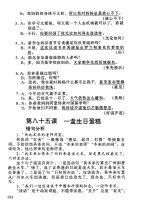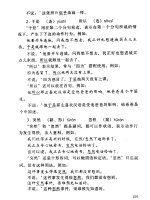2 7 dinosaur fossils (earth science)
Bạn đang xem bản rút gọn của tài liệu. Xem và tải ngay bản đầy đủ của tài liệu tại đây (2.59 MB, 10 trang )
Genre
Nonfiction
Comprehension Skill
Retell
Text Features
• Labels
• Glossary
Science Content
Fossils and
Dinosaurs
Scott Foresman Science 2.7
ISBN 0-328-13788-X
ì<(sk$m)=bdhi g< +^-Ä-U-Ä-U
Vocabulary
What did you learn?
dinosaurs
extinct
fossil
paleontologist
1. Which is the biggest dinosaur ever
found? Where was it found?
2. What is a fossil?
3.
4.
Picture Credits
Every effort has been made to secure permission and provide appropriate credit for photographic material.
The publisher deeply regrets any omission and pledges to correct errors called to its attention in subsequent editions.
Photo locators denoted as follows: Top (T), Center (C), Bottom (B), Left (L), Right (R), Background (Bkgd).
5 ©Jonathan Blair/Corbis; 8 Bettmann/Corbis.
Unless otherwise acknowledged, all photographs are the copyright © of Dorling Kindersley, a division of Pearson.
ISBN: 0-328-13788-X
Copyright © Pearson Education, Inc. All Rights Reserved. Printed in the United States of America.
This publication is protected by Copyright, and permission should be obtained from the publisher prior to any
prohibited reproduction, storage in a retrieval system, or transmission in any form by any means, electronic,
mechanical, photocopying, recording, or likewise. For information regarding permission(s), write to
Permissions Department, Scott Foresman, 1900 East Lake Avenue, Glenview, Illinois 60025.
3 4 5 6 7 8 9 10 V010 13 12 11 10 09 08 07 06 05
by Kim
Paleontologists
studyBorland
living things
from long ago. What do you think
a paleontologist’s day might be
like? Write to tell your ideas. Use
words from the book as you write.
Retell On page 4, the author
explains how a dinosaur fossil
might form. Using your own words,
retell how this might happen.
Millions of years ago, dinosaurs roamed
the Earth. Dinosaurs of all shapes and sizes
lived together on the land.
Tyrannosaurus rex
The dinosaurs
disappeared from
the Earth before
there were any people
to see them, tell about them, or draw
pictures of them. So how do we know
so much about them? Let’s find out!
Triceratops
Stegosaurus
Diplodocus
2
3
Learning About
the Past
This paleontologist is looking at
the fossil skull of a small kind of
T. rex, called an Albertosaurus.
Everything we know about dinosaurs comes
from fossils. A fossil can be a very old bone,
a tooth, a footprint, or even a piece of skin.
A paleontologist is a scientist who studies
fossils. These paleontologists are studying the
fossils of a Tyrannosaurus rex, T. rex for short,
that lived more than 67 million years ago.
How did dinosaur
fossils form?
paleontologists’
tools
Paleontologists think this
dinosaur fell into a river when
it died. It was buried under soft
sand and mud. When the river
dried up, the sand and mud
turned into rock. Over millions
of years, this dinosaur’s bones
turned into rock too. These are
the fossils we find today.
4
5
What can we learn
from fossils?
Fossils are like a
journal. They tell us what
the Earth was like in the
past. By studying fossils,
paleontologists learn
interesting things about
different dinosaurs.
What did dinosaurs really look like? How big
were they? How did their bodies work? What did
they eat? How did they move? Paleontologists
ask these questions as they study dinosaur fossils.
fossil of
Saltasaurus
skin
This rock contains
a bird fossil.
Triceratops
6
Tyrannosaurus rex
7
What were
dinosaurs like?
The first T. rex fossil was
discovered in Montana more than
one hundred years ago! Since then,
paleontologists have found other
T. rex fossils. They know that this
huge dinosaur had long, strong leg
bones. It had very short arms.
Each arm had two claws.
Workers find part of a T. rex skeleton
in Hell Creek, Montana.
8
T. rex skull
In 1990 a paleontologist
made an important discovery.
She saw three large bones
poking out of a mountain. The bones were
part of the most complete skeleton of a T. rex
ever found. The most interesting fossil was
the dinosaur’s skull. By studying the skull,
paleontologists learned that T. rex had
a powerful sense of smell.
9
Animals and plants that no longer live on
Earth are extinct. Dinosaurs disappeared from
the Earth a long time ago. They are extinct.
For some reason the dinosaurs’ habitat could no
longer meet their needs. Some paleontologists
think that this is because their habitat changed.
Paleontologists know that some dinosaurs
were as tall as buildings. Some were as
small as chickens. Some dinosaurs
ate leaves and fruits. Some ate
other animals.
By studying dinosaur
tracks, paleontologists
know that some dinosaurs
moved slowly on four
legs. Some raced
on two legs.
Euoplocephalus
Brachiosaurus
twolegged
dinosaur
Coelophysis
fourlegged
dinosaur
These are dinosaur
footprints.
Gallimimus
10
11
Studying Dinosaurs
By studying the fossils of a Barosaurus
(ba-ruh-SAW-ruhs), paleontologists know
that this dinosaur had a long, strong neck.
The dinosaur could stand on its back legs and
reach the highest trees. It used its tiny teeth
to pull leaves off branches.
By studying the fossils of the Triceratops
(try-SE-ruh-tops), paleontologists know
that its babies were born with three horns.
The three horns got bigger as the dinosaur
grew older.
Fossils of baby Protoceratops show that
it was born with its head frill.
head frill
Diplodocus skull
Protoceratops
Barosaurus
Protoceratops
babies
12
13
New Discoveries
For many years paleontologists thought T. rex
was the largest meat-eating dinosaur. In 1993
a paleontologist made an amazing discovery.
He found the fossils of a Gigantosaurus
in Argentina. This dinosaur was even bigger
than T. rex!
Are there even bigger dinosaur fossils to
be found? Paleontologists are always looking
for new fossil clues. Each discovery tells us
more about how these animals lived. So keep
your eyes open. Maybe the next big dinosaur
discovery will be yours!
Gigantosaurus
Tyrannosaurus rex was 39 feet long.
Gigantosaurus was 45 feet long.
How much longer was Gigantosaurus?
Tyrannosaurus rex
14
15
Vocabulary
Glossary
dinosaurs
extinct
fossil
dinosaurs
extinct animals that lived
paleontologistlong ago
extinct
fossil
a plant or animal that no longer
lives on Earth
What did you learn?
1. Which is the biggest dinosaur ever
found? Where was it found?
2. What is a fossil?
3.
Paleontologists study living things
from long ago. What do you think
a paleontologist’s day might be
like? Write to tell your ideas. Use
words from the book as you write.
a print or remains of a plant or
animal that lived long ago
paleontologist a scientist who studies fossils
4.
Picture Credits
Every effort has been made to secure permission and provide appropriate credit for photographic material.
The publisher deeply regrets any omission and pledges to correct errors called to its attention in subsequent editions.
Photo locators denoted as follows: Top (T), Center (C), Bottom (B), Left (L), Right (R), Background (Bkgd).
5 ©Jonathan Blair/Corbis; 8 Bettmann/Corbis.
Unless otherwise acknowledged, all photographs are the copyright © of Dorling Kindersley, a division of Pearson.
ISBN: 0-328-13788-X
Copyright © Pearson Education, Inc. All Rights Reserved. Printed in the United States of America.
This publication is protected by Copyright, and permission should be obtained from the publisher prior to any
prohibited reproduction, storage in a retrieval system, or transmission in any form by any means, electronic,
mechanical, photocopying, recording, or likewise. For information regarding permission(s), write to
Permissions Department, Scott Foresman, 1900 East Lake Avenue, Glenview, Illinois 60025.
16
3 4 5 6 7 8 9 10 V010 13 12 11 10 09 08 07 06 05
Retell On page 4, the author
explains how a dinosaur fossil
might form. Using your own words,
retell how this might happen.









